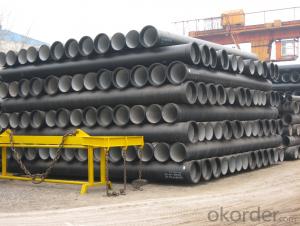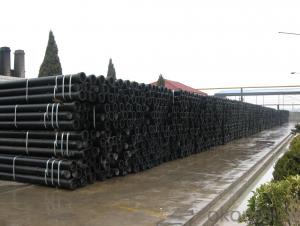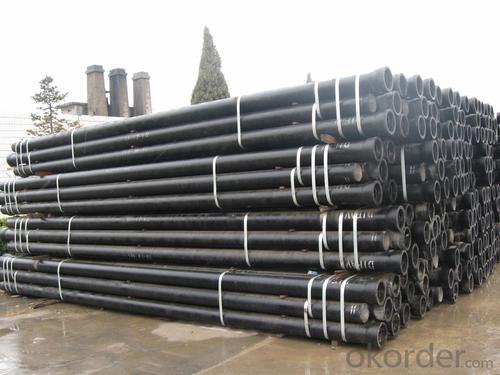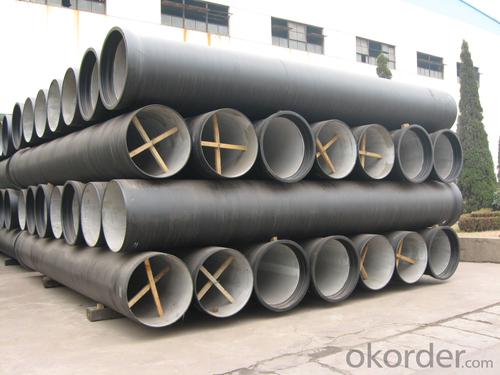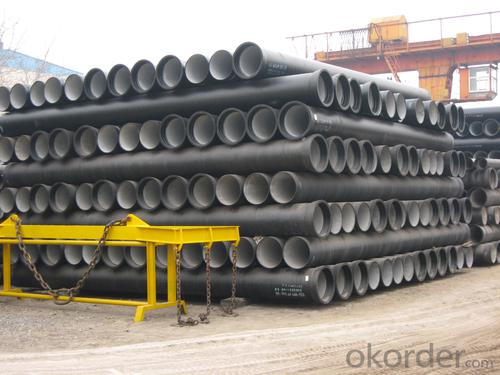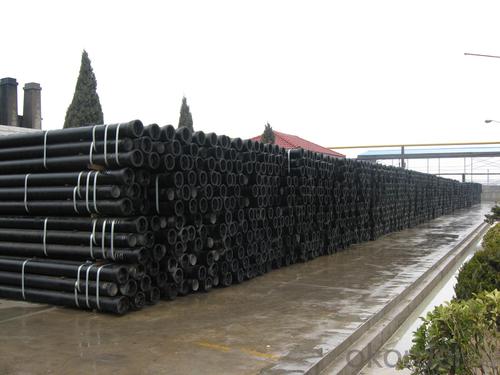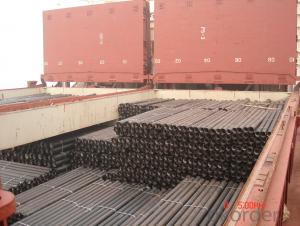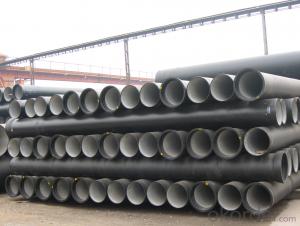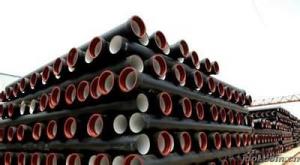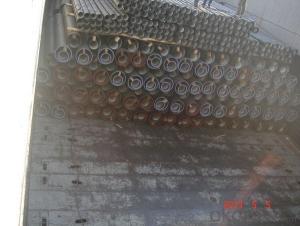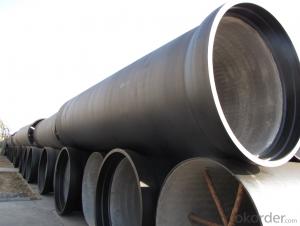DUCTILE IRON PIPE DN1100 K8/C/K9
- Loading Port:
- China Main Port
- Payment Terms:
- TT OR LC
- Min Order Qty:
- -
- Supply Capability:
- -
OKorder Service Pledge
OKorder Financial Service
You Might Also Like
Specification:
1) The standard of pipe: ISO2531:1998, K9
2) Effective length: 6m
3) Inner cement line: Portland cement line as per ISO4179
4) Zinc coating: at least 130g/m2 as per ISO8179
5) Bitumen painting: at least 70um as per ISO8179
6) With 100% quantity of NBR ring, or SBR ring, or EPDM ring as per ISO4633
7) DN80mm-800mm
8) High strength, lighter than grey iron, good corrosion resistance, no furring, small flow resistance, easy fixing, long life tome about 100 yeas
9) Produced by Hangzhou chunfeng machine
10) Checked by automatic inspection equipment
11) Composition:
Chemical composition | | | | |||
Chemical composition | Ductile Cast Iron Pipe (%) | Grey iron pipe (%) | Steel pipe (%) | | | |
C | 3.5-4.0 | 3.2-3.8 | 0.1-0.2 | | | |
Si | 1.9-2.6 | 1.4-2.2 | 0.15-0.4 | | | |
Mn | 0.15-0.45 | 0.4-0.6 | 0.3-0.6 | | | |
P | ≤0.06 | ≤0.3 | 0.02-0.03 | | | |
S | ≤0.02 | ≤0.1 | 0.02-0.03 | | | |
Mg | 0.03-0.06 |
|
| | | |
12) Feature:
Mechanical properties | | | | |||
| Ductile Cast Iron Pipe | Grey Iron Pipe | Steel Pipe | | | |
Tensile Strength(Mpa) | ≥420 | 150-260 | ≥400 | | | |
Yield Strength(Mpa) | ≥300 | No Confirmation | No Confirmation | | | |
Bending Strength(Mpa) | ≥590 | 200-360 | ≥400 | | | |
Elongation (%) | ≥10 | Neglected | ≥18 | | | |
Brinell Hardness(HBS) | ≤230 | ≤230 | About 140 | | | |
13) T type mechanical joint
14) Packing: in bulk or container
- Q: How do ductile iron pipes compare to PVC pipes in terms of strength?
- PVC pipes are generally considered to be less strong than ductile iron pipes. Ductile iron, a type of cast iron, is strengthened and made more flexible through the addition of small amounts of magnesium. This treatment enhances its resistance to cracking and breaking under pressure, making it suitable for various applications including water and wastewater transportation. In contrast, PVC pipes are made from a plastic known as polyvinyl chloride. While PVC pipes are relatively durable, they do not possess the same level of strength as ductile iron pipes. They are more susceptible to cracking and breaking when subjected to high pressure or extreme temperature changes. PVC pipes are commonly utilized in low-pressure systems such as irrigation and drainage. In terms of strength, ductile iron pipes exhibit greater tensile strength and can endure higher internal and external pressures compared to PVC pipes. Additionally, ductile iron pipes have a higher resistance to impacts, reducing the likelihood of damage from external forces like heavy machinery or accidental impacts. However, it is important to consider specific project requirements when choosing between ductile iron and PVC pipes. Factors such as cost, ease of installation, corrosion resistance, and the nature of the fluid being transported should all be taken into account.
- Q: Can ductile iron pipes be used for above-ground installations?
- Yes, ductile iron pipes can be used for above-ground installations. Ductile iron is a type of cast iron that has higher tensile strength and flexibility, making it suitable for a variety of applications including above-ground installations. It is commonly used for water distribution systems, sewage systems, and industrial pipelines. Ductile iron pipes are resistant to corrosion, withstand high pressure and temperature, and have a long lifespan. They are also available in various sizes and can be easily connected using different joint types. However, it is important to ensure proper support and protection against external factors such as sunlight and impact to prevent any potential damage.
- Q: What is the expected surge pressure rating of ductile iron pipes?
- The expected surge pressure rating of ductile iron pipes can vary depending on various factors such as the diameter and thickness of the pipe, the type of joint used, and the specific manufacturer's specifications. However, ductile iron pipes are generally designed to withstand surge pressures between 150% to 200% of their working pressure rating. This means that if a ductile iron pipe has a working pressure rating of, for example, 250 psi, it can typically handle surge pressures of up to 375 psi to 500 psi. It is important to consult the manufacturer's specifications and guidelines for accurate surge pressure ratings specific to the ductile iron pipes being used.
- Q: What is the expected joint deflection of ductile iron pipes?
- The expected joint deflection of ductile iron pipes depends on various factors such as the diameter, wall thickness, and type of joint used. However, in general, ductile iron pipes are designed to have a joint deflection capability of up to 5 degrees for restrained joints and up to 10 degrees for flexible joints.
- Q: How do ductile iron pipes perform in high-traffic areas?
- Due to their inherent strength and durability, ductile iron pipes exhibit exceptional performance in high-traffic areas. The composition of these pipes includes graphite nodules, which impart them with their characteristic ductility. This ductility enables the pipes to flex and endure heavy loads and vibrations caused by traffic without experiencing any cracks or breaks. In areas with high traffic, where the ground is constantly in motion and subjected to heavy vehicle loads, ductile iron pipes demonstrate superior resistance to stress and impact. Their capacity to absorb and distribute the pressure from traffic ensures that these pipes maintain their structural integrity over time. This aspect is particularly significant since any damage or failure in a pipe system can lead to expensive repairs and disruptions in the water supply. Moreover, ductile iron pipes possess a high level of resistance to corrosion, making them suitable for installation in high-traffic areas exposed to diverse environmental conditions. Typically, these pipes are lined with a protective layer, such as cement mortar or epoxy, which provides an additional barrier against external factors. This resistance to corrosion guarantees the longevity of the pipes and reduces the need for frequent maintenance or replacement. Furthermore, ductile iron pipes exhibit excellent flow characteristics, enabling efficient water distribution even in areas with high traffic demands. The smooth interior surface of these pipes minimizes friction and pressure losses, ensuring a consistent and reliable water supply to meet the needs of the surrounding population. In conclusion, ductile iron pipes are a reliable and robust choice for high-traffic areas. Their strength, durability, resistance to corrosion, and efficient flow characteristics make them well-suited to withstand the demands and challenges posed by heavy traffic. They guarantee the continuous supply of water without compromising the structural integrity of the pipe system.
- Q: What is the expected flow capacity of ductile iron pipes?
- The flow capacity of ductile iron pipes can vary depending on several factors, including the diameter and wall thickness of the pipe, the type of fluid being transported, and the specific design and condition of the pipeline system. It is well-known that ductile iron pipes have a high flow capacity due to their smooth internal surface, which minimizes frictional losses. They are designed to handle a wide range of fluid flows, including water, sewage, and industrial fluids. To determine the specific flow rates, the Manning's equation is commonly used. This equation takes into account the hydraulic radius, slope of the pipe, and Manning's roughness coefficient to calculate the expected flow capacity of open channels and pipes. However, it's important to consider other factors that can affect the actual flow capacity. These factors include the presence of fittings, valves, and bends in the pipeline, as well as any potential blockages or obstructions. To accurately determine the expected flow capacity of ductile iron pipes for a particular application, it is recommended to consult the manufacturer's specifications, engineering guidelines, or work with a qualified engineer.
- Q: Can ductile iron pipes be used for gravity sewer systems?
- Yes, ductile iron pipes can be used for gravity sewer systems. Ductile iron pipes are known for their durability, strength, and resistance to corrosion, making them suitable for various applications including sewer systems. These pipes have excellent tensile strength and can withstand high pressure and heavy loads, making them ideal for gravity sewer systems where wastewater flows by gravity rather than being pumped. Additionally, ductile iron pipes have a long lifespan and require minimal maintenance, making them a cost-effective choice for sewer infrastructure.
- Q: What is the difference between cast iron pipe and seamless steel pipe and galvanized steel pipe?
- Galvanized steel pipe: divided into cold galvanized steel pipe, hot galvanized steel pipe, cold galvanized steel pipe has been banned, and the latter is also advocated by the state for the time being. In 60s and 70s, developed countries began to develop new types of pipes, and galvanized pipes were banned. China's Ministry of construction and other four ministries also issued a civilization, indeed from two, 000 years since the galvanized pipe as a water supply pipe, the New District cold water pipe has rarely used galvanized pipe, and some of the hot water pipe is galvanized pipe. Hot dip galvanized steel pipe is widely used in fire, power and highway.
- Q: How do ductile iron pipes compare to PVC pipes?
- Plumbing and water distribution systems commonly utilize ductile iron pipes and PVC pipes. When comparing these materials, various factors should be taken into account. Strength and Durability: Ductile iron pipes are renowned for their exceptional strength and durability. They can withstand high pressure and heavy loads, making them suitable for underground and high-traffic areas. Conversely, PVC pipes are less sturdy and more prone to cracking under extreme conditions. However, PVC pipes have the advantage of being corrosion-resistant and do not rust, which is beneficial in certain environments. Installation and Maintenance: Ductile iron pipes are heavier and require specialized equipment and skilled labor for proper installation. In contrast, PVC pipes are lightweight and easy to handle, making installation simpler and quicker. Additionally, PVC pipes require less maintenance as they do not corrode or develop mineral deposits over time, unlike ductile iron pipes which may need regular cleaning and maintenance to prevent rust and sediment buildup. Cost: PVC pipes generally have a lower cost compared to ductile iron pipes. The lower material and installation expenses associated with PVC pipes make them a popular choice for budget-friendly residential and commercial plumbing projects. Ductile iron pipes, while offering superior strength and durability, tend to be more expensive due to the higher cost of materials, specialized installation requirements, and additional maintenance expenses. Environmental Impact: PVC pipes are made from non-renewable resources and can have a negative environmental impact during production and disposal. On the other hand, ductile iron pipes are made from recycled iron and have a longer lifespan, reducing the need for replacement and minimizing waste. However, it is important to note that PVC pipes can be recycled, and many manufacturers have implemented sustainable practices to minimize their environmental footprint. In conclusion, ductile iron pipes and PVC pipes possess distinct characteristics that make them suitable for different applications. Ductile iron pipes excel in strength and durability, making them ideal for heavy-duty applications, while PVC pipes offer cost-effectiveness, easy installation, and corrosion resistance. Ultimately, the choice between the two materials depends on the specific requirements, budget, and environmental considerations of the project.
- Q: What is a graphite cast iron pipe?
- Ordinary cast iron consists of gray cast iron and ductile iron, the difference is the carbon in cast iron (graphite) exist, graphite in gray cast iron is in the shape of flake, so the strength and toughness are poor; graphite in shape is spherical, with little on dissevered the matrix. So strong and toughness will be much better.
Send your message to us
DUCTILE IRON PIPE DN1100 K8/C/K9
- Loading Port:
- China Main Port
- Payment Terms:
- TT OR LC
- Min Order Qty:
- -
- Supply Capability:
- -
OKorder Service Pledge
OKorder Financial Service
Similar products
Hot products
Hot Searches
Related keywords


